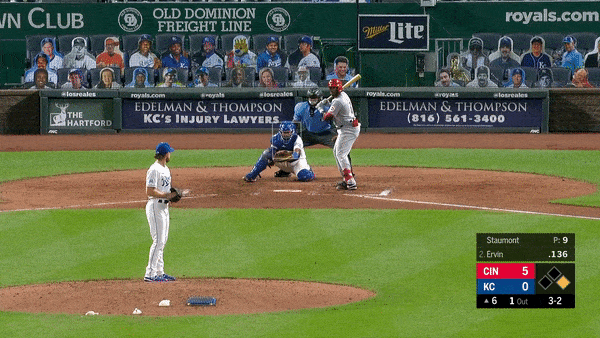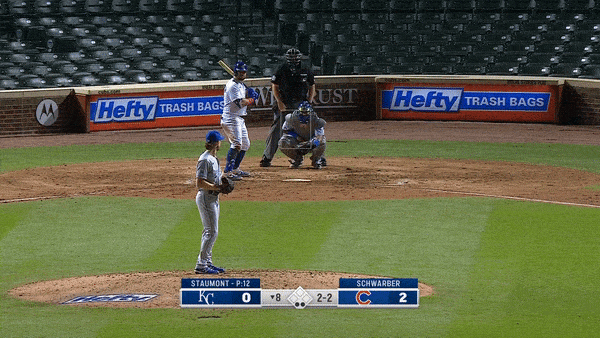
Baseball has become a power game. We measure exit velocity, pitch velocity, launch angle, distance and spin rate. Two decades into the 21st century, it’s become rote. Pitchers throw the ball with extreme force. Hitters hit the ball with a similar extreme force. Power rules the game.
Just because it’s become commonplace doesn’t mean power can’t awe the viewer.
On August 19, 2020, against the Cincinnati Reds, Josh Staumont entered the second game of a doubleheader with his team trailing 5-0 in the sixth. That day he threw 14 pitches, 10 for strikes, and retired both batters he faced on strikeouts. Just another day on the bump for the right-hander.
Or was it?
In that game, among those pitches, Staumont uncorked four fastballs that were recorded at 101 mph or faster. Three of those four were the fastest pitches he threw all season at 101.9 mph, 102.0 mph and 102.2 mph.
The temperatures in Kansas City this month have been brutally cold. Maybe this gif of straight heat will warm you up.
That was the strikeout of poor Phil Ervin who was sent up as a sacrificial pinch-hitter for Nick Castellanos. To his credit, Ervin battled—he saw 10 pitches total and fouled off five straight, including that strikeout—but he was ultimately no match for the heat.
Staumont’s next victim was Jesse Winker. Unlike Ervin, he went down rather easily—four pitches were required. Like Ervin, he was punched out on a high heater. This one at 101.9.
On his four-seam fastball, Staumont’s 32.3 percent whiff rate is nothing particularly special. Oh, it’s a good rate. Great even. But it ranked 34th on the leaderboard of four-seam Whiff%. I guess this is where my bias is creeping in. I expected it to be a little…higher.
What made that fastball so difficult to make contact with was its location. Despite what the Royals’ television broadcast would have you believe, it’s insanely difficult for a major league hitter to catch up with 98 mph smoke elevated in the strike zone. Both of those pitches represented above were elevated in the strike zone. Imagine what would’ve happened if either batter had actually made contact.
It was a familiar neighborhood for Staumont and his four-seamer in 2020.
Overall, opposing batters hit .224 with a .241 slugging percentage against his four-seamer in 2020. When he elevated that four-seam fastball (which I’m defining here as anything in the top third of the strike zone and above) that batting average dropped to .188.
The four-seamer was faster than what he offered in 2019, on average, by about two mph and was much more successful. In an interview with Fangraphs’ David Laurila last week, Staumont attributed his four-seam success to not cutting the ball as much and making one other crucial adjustment.
“We’ve also kind of changed my release point, moving away from my ear a tiny bit. That’s allowed the ball to kind of do its own thing and really take that life forward.”
I love it when a pitcher makes a statement like this because it’s so easy to check the data. Wouldn’t you know it…Staumont did alter his release point, moving it closer to his body. And definitely coming at hitters from there on a much more consistent basis than he did in 2019.
Staumont compliments his four-seamer with a hammer curve. It’s notable in that it has an average spin rate of over 2,900 RPMs, which places it in the 91st percentile among spin rate. Like the four-seamer, it’s an elite pitch, often resulting in a similar result. It just makes hitters look…different.
From the Cubs’ broadcast when Kyle Schwarber attempted to swing, the only commentary provided was, “Wow.” That feels appropriate. Wow, indeed.
Staumont doesn’t live in the zone as much with the curve as he does with the four-seamer. In fact, it’s a little scattershot where that breaking ball may end up.
As such, he threw it just around 12 percent of the time when the opposing batter was ahead in the count. If he missed with his first pitch, his second pitch was going to be the heater. Conversely, he offered the curve around 44 percent of the time when he was ahead.
The curve was a weapon. He offered his breaking pitch around 44 percent of the time when he was ahead, but actually backed off the pitch just a bit when he pushed the batter to two strikes, offering it around 39 percent of the time. Opponents hit just .172 against the pitch.
At this point, I would be remiss to not mention that Staumont also throws a sinking, two-seam fastball as well. Offering it just around four percent of the time, he throws it almost exclusively to left-handed batters. It’s notable because he throws the sinker harder than his four-seam. He mentioned this to Laurila:
“There’s this tale as old as time where everyone believes four-seams are harder, but I actually throw my two-seam harder. Every time. So we’ll use those intermittently, and not just the four. It’s one of those things where you have to understand yourself, knowing what works and what doesn’t. The two is more recent, just because I was at a point where I was repeating well enough to introduce something new. This next year, I think it’s going to come in more.”
It will be interesting to see how much more he incorporates that two-seamer into his repertoire in 2021.
Much has been made batters making quality contact against Staumont. According to Statcast, Staumont’s Hard Hit % of 50 percent was in the second percentile among all major league pitchers.
Look, I’m no physics guru (as if there was a question), but this checks out. We hear all the time that a professional hitter will be able to adjust and time an extreme fastball. Throw 100 mph enough and a hitter will get his timing down so he can get his bat to the ball. And these dudes are swinging aggressively. Force plus more force equals a metric crap-ton of force. (Maybe I should rethink my previous statement about not being a physics guru. I think I’m on to something.) I just kind of makes sense that if a hitter squares up a Staumont fastball that it will travel with an elevated exit velocity.
But the good news is, that doesn’t happen all that often. His barrel rate is in the 70th percentile (which is good) and his xBA and xSLG of .198 and .320 respectively in 2020 underscore that even though the opposition may be hitting the ball hard against Staumont, a hard-hit baseball doesn’t guarantee results.
Also, Staumont is more of a Two True Outcomes kind of guy. With a strikeout rate of 33 percent and a walk rate of 14.3 percent, over 47 percent of all batters Staumont faces fail to put the ball in play. So a 50 percent Hard Hit % isn’t the same for Staumont as it is for mere mortal pitchers.
The Projections
PECOTA - 12.16 SO/9, 6.66 BB/9, 5.10 ERA, -0.3 WARP
THE BAT - 10.86 SO/9, 6.54 BB/9, 4.46 ERA
Steamer - 11.03 SO/9, 5.16 BB/9, 4.16 ERA, 0.4 fWAR
ZiPS - 10.6 SO/9, 7.03 BB/9, 4.80 ERA, 0.5 fWAR
These are…kind of fun? The projections obviously pick up the underlying themes of Staumont (high strikeout and high walk rates) but to varying degrees.
Manager Mike Matheny used Staumont in an ideal fashion out of the bullpen last season. He let him go multiple innings a few times. He brought the right-hander in with the Royals ahead in 11 of his 26 appearances. He brought him in with the game tied or with the Royals trailing by one or two runs 12 times. He generally pitched when it mattered, when the game was in the balance. But of those 26 appearances, Matheny brought Staumont into a game with runners already on base exactly twice. Give credit where it’s due. It’s was smart managing.
It’s not surprising given the small sample of 2020, and relief pitching in general, Staumont’s rough outings can be distilled into two appearances. On September 6 against the White Sox he faced five batters, walked two and allowed two hits, including a home run. On September 24 against the Tigers he faced six batters, gave up four hits and didn’t record a strikeout. In that combined inning of work, Staumont allowed six of the seven earned runs he allowed in 2020. On the flip side, in 12 of his 26 appearances, he struck out two or more batters.
Although he put runners on base at an above average clip overall, Staumont’s 2.45 ERA in 2020 points to a strand rate that finished north of 85 percent, almost 15 percent better than league average. If he continues to put runners on base at that rate—and there’s every expectation he will—it’s expecting too much that his ERA remain below 3. Or even, according to the projections above, below 4.
Personally, I remain bullish on Staumont coming out of the pen. He’s not closer material, not with those walks, but he has shown an ability to largely avoid the meltdown inning. Avoiding the meltdown inning isn’t a repeatable skill and while Staumont may very well have his share of them in 2021, his power will still make him a very fun reliever to watch.









